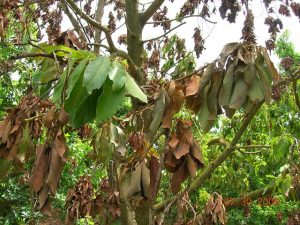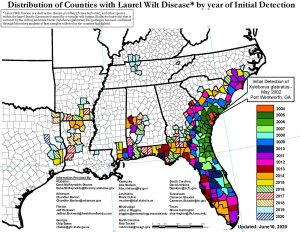
Shannon Kennedy, ANR Educator, UGA Extension Forsyth County
Just last month, Hallie Harriman, a colleague from Cobb County, mentioned that a stand of sassafras trees in her county that were suffering from a mysterious disease. Their leaves were wilting prematurely, and the sapwood under the bark was discolored. Fortunately, I had not heard of anything in Forsyth County that would fit the symptoms she described. Then, two weeks later, I received an email.
The pathogen afflicting the Cobb sassafras trees was confirmed as laurel wilt.
Laurel wilt was first identified at Port Wentworth in 2002. It has since spread throughout the southeastern coastal planes, as far west as Texas and as far north as South Carolina. This recent sighting is the furthest north this pathogen has been documented in Georgia.

Laurel wilt is caused by the fungus Raffaelea lauricola, and it attacks plants in the laurel family (Lauraceae). This includes ornamental and native laurels, native bays, sassafras, northern spicebush, and avocado trees. It has killed one-third of the redbay population, and it has caused heavy damage to avocado production in the Southeast.
The redbay ambrosia beetle (Xyleborus glabratus), an invasive boring beetle native to Asia, carries the fungus. The beetles are transported in infested wood or when infested plants are moved. Redbay ambrosia beetles are tiny insects, roughly two millimeters long, with brown-black coloration. They can be elusive, so you’ll be more likely to see boreholes or the “toothpicks” of sawdust that the beetles push out of the trunk.

When laurel wilt fungus infects a tree, it begins to clog the plant’s vascular tissue, starving the outer branches of water and nutrients. This deprivation becomes clear when leaves begin to wilt and discolor. In deciduous species the leaves die and fall from the tree, and in evergreen species, the leaves will fully discolor and remain on the stem. If the bark is peeled back from a diseased plant, the sapwood will have brownish streaks along the grain of the wood. Infection quickly kills the host tree.
Laurel wilt kills the host trees of some of our pollinator species, including spicebush swallowtail butterflies, spicebush silk moths, and tiger swallowtail butterflies, which depend exclusively on the leaves of spicebush, sassafras, and/or redbays to house and feed their caterpillars. As laurel wilt spreads, it limits the availability of food to these species.
If you suspect laurel wilt is present in your area please contact Forsyth County Extension, a Georgia Forestry Commission representative, or a certified arborist for confirmation. Once it’s confirmed, eradication and sanitation options can be provided; there is little chance that infected plants will survive. In cases like this, prevention is the key to success. The more information we as a community collect on this disease, the better able we will be to develop management strategies when we see it in our environment.